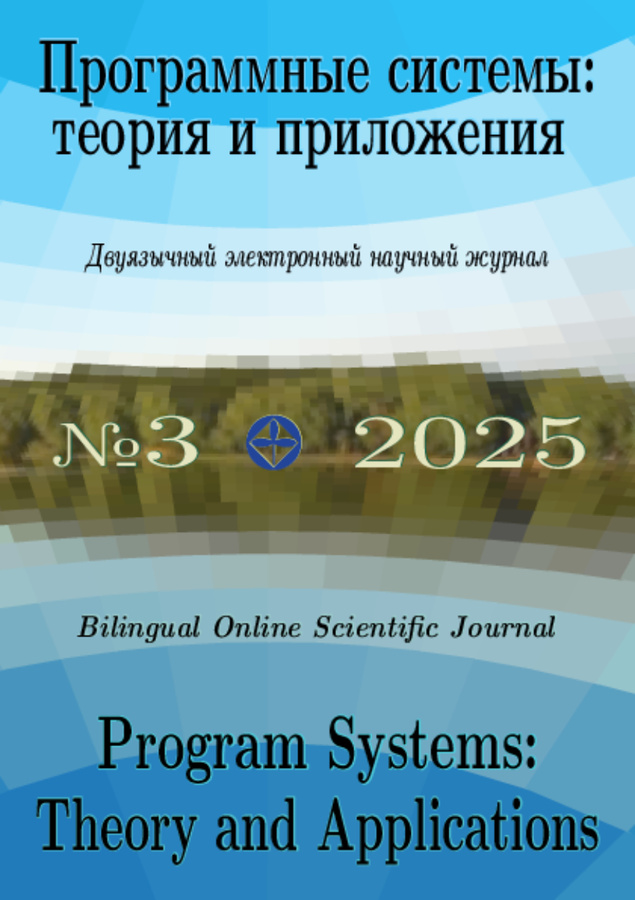Определение здоровых и больных областей листьев растений при помощи нейронных сетей
- Авторы: Смирнов А.В.1, Тищенко И.П.1
-
Учреждения:
- Институт программных систем им. А. К. Айламазяна РАН
- Выпуск: Том 16, № 3 (2025)
- Страницы: 69-97
- Раздел: Статьи
- URL: https://bakhtiniada.ru/2079-3316/article/view/309578
- DOI: https://doi.org/10.25209/2079-3316-2025-16-3-69-97
- ID: 309578
Цитировать
Полный текст
Аннотация
Ключевые слова
Об авторах
Александр Владимирович Смирнов
Институт программных систем им. А. К. Айламазяна РАН
Email: asmirnov_1991@mail.ru
Младший научный сотрудник Лаборатории методов обработки и анализа изображений, Институт Программных Систем имени А. К. Айламазяна РАН. Научные интересы: компьютерное зрение; нейронные сети; робототехника; автоматизация и управление
Игорь Петрович Тищенко
Институт программных систем им. А. К. Айламазяна РАН
Email: igor.p.tishchenko@yandex.ru
Кандидат технических наук, ИО директора, Институт Программных Систем имени А. К. Айламазяна РАН. Научные интересы: компьютерное зрение; нейронные сети; робототехника; автоматизация и управление
Список литературы
- Fenu G., Malloci F. „DiaMOS Plant: A dataset for diagnosis and monitoring plant disease“, Agronomy, 2021, no.11, 2107, 12 pp.
- Liu X., Min W., Mei S., Wang L., Jiang S. „Plant disease recognition: A large-scale benchmark dataset and a visual region and loss reweighting approach“, IEEE Transactions on Image Processing, 30 (2021), pp. 2003–2015.
- Ahmad A., Saraswat D., El Gamal A. „A survey on using deep learning techniques for plant disease diagnosis and recommendations for development of appropriate tools“, Smart Agricultural Technology, 3 (February 2023), 100083.
- Shoaib M., Shah B., EI-Sappagh S., Ali A., Ullah A., Alenezi F., Gechev T., Hussain T., Ali F. „An advanced deep learning models-based plant disease detection: A review of recent research“, Frontiers in Plant Science, 14 (2023), 1158933, 22 pp.
- O'Shea K., Nash R. An introduction to convolutional neural networks, 2015, 11 pp.
- Schmidt R. Recurrent Neural Networks (RNNs): A gentle introduction and overview, 2019, 16 pp.
- Cohen G., Giryes R. Generative adversarial networks, 2022, 28 pp.
- Zhuang F., Qi Z., Duan K., Xi D., Zhu Y., Zhu H., Xiong H., He Q. „A comprehensive survey on transfer learning“, Proceedings of the IEEE, 109:1 (2021), pp. 43–76.
- Ronneberger O., Fischer P., Brox T. „U-Net: Convolutional networks for biomedical image segmentation“, Medical Image Computing and Computer-Assisted Intervention – MICCAI 2015 (Munich, Germany, October 5–9, 2015), Lecture Notes in Computer Science (LNIP), vol. 9351, Springer, Cham, 2015, ISBN 978-3-319-24573-7, pp. 234–241.
- He K., Gkioxari G., Dollar P., Girshick R. „Mask R-CNN“, 2017 IEEE International Conference on Computer Vision (ICCV) (Venice, Italy, October 22–29, 2017), 2017, ISBN 9781538610336, pp. 2980–2988.
- Ahmad N., Asif H., Saleem G., Younus M., Anwar S., Anjum M. „Leaf image-based plant disease identification using color and texture features“, Wireless Personal Communications, 121 (2021), pp. 1139–1168.
- V. B.Sebastian, Unnikrishnan A., Balakrishnan K. „Grey level co-occurrence matrices: Generalisation and some new features“, International Journal of Computer Science, Engineering and Information Technology, 2:2 (2012), pp. 151–157.
- Gajjar R., Gajjar N., Thakor V., Patel N., Ruparelia S. „Real-time detection and identification of plant leaf diseases using convolutional neural networks on an embedded platform“, The Visual Computer, 38:8 (2021), pp. 2923–2938.
- Kumari P., Ranjan P., Srivastava P. „Classification and assessment of visual content of medicinal plants using CNN“, Handbook of Research on Innovative Approaches to Information Technology in Library and Information Science, IGI Global, 2024, ISBN 9798369308073, pp. 126–147.
- He W., Zhou T., Xiang Y., Lin Y., Hu J., Bao R. Deep learning in image classification: Evaluating VGG19's performance on complex visual data, 2024, 5 pp.
- Vishnoi V., Kumar K., Kumar B., Mohan S., Khan A. „Detection of apple plant diseases using leaf images through convolutional neural network“, IEEE Access, 11 (2023), pp. 6594-6609.
- Sharma S., Sharma G., Menghani E. „Tomato plant disease detection with pretrained CNNs“, Artificial Intelligence in Medicine and Healthcare, 1st ed., CRC Press, 2025, ISBN 9781003508595, pp. 67–85.
- Xu P., Fang N., Liu N., Lin F., Yang S., Ning J. „Visual recognition of cherry tomatoes in plant factory based on improved deep instance segmentation“, Computers and Electronics in Agriculture, 197 (June 2022), 106991.
- Tang W., Sun J., Wang S., Zhang Y. „Review of AlexNet for medical image classification“, EAI Endorsed Transactions on e-Learning, 9 (December 2023), 13 pp.
- Iandola F., Han S., Moskewicz M., Ashraf K., Dally W., Keutzer K. SqueezeNet: AlexNet-level accuracy with 50x fewer parameters and $<0.5$MB model size, 2016, 13 pp.
- Ren S., He K., Girshick R., Sun J. Faster R-CNN: Towards real-time object detection with region proposal networks, 2016, 14 pp.
- Yag I., Altan A. „Artificial intelligence-based robust hybrid algorithm design and implementation for real-time detection of plant diseases in agricultural environments“, Biology, 11:12 (2022), 1732, 30 pp.
- Yang X. „Flower pollination algorithm for global optimization“, Unconventional Computation and Natural Computation (UCNC 2012) (Orléans, France, September 3–7, 2012), Lecture Notes in Computer Science, vol. 7445, Springer, Berlin–Heidelberg, 2012, ISBN 978-3-642-32893-0, pp. 240–249.
- Pal A. „AgriDet: Plant Leaf Disease severity classification using agriculture detection framework“, Engineering Applications of Artificial Intelligence, 119 (March 2023), 105754.
- Di Mascio T., Fantozzi P., Laura L., Rughetti V. „Age and gender (face) recognition: A brief survey“, Methodologies and Intelligent Systems for Technology Enhanced Learning, 11th International Conference (MIS4TEL 2021) (Salamanca, Spain, September 6–8, 2021), Lecture Notes in Networks and Systems, vol. 326, Springer, Cham, 2022, ISBN 978-3-030-86617-4, pp. 105–113.
- Lin T., Dollar P., Girshick R., He K., Hariharan B., Belongie S. „Feature pyramid networks for object detection“, 2017 IEEE Conference on Computer Vision and Pattern Recognition (CVPR) (Honolulu, HI, USA, July 21–26, 2017), 2017, ISBN 9781538604588, pp. 936–944.
- He K., Zhang X., Ren S., Sun J. „Deep residual learning for image recognition“, 2016 IEEE Conference on Computer Vision and Pattern Recognition (CVPR) (Las Vegas, NV, USA, June 27–30, 2016), 2016, ISBN 9781467388528, pp. 770–778.
Дополнительные файлы











